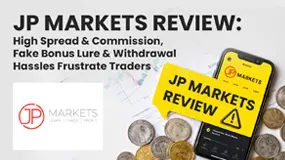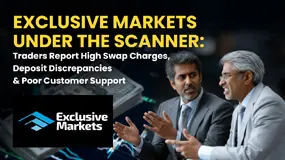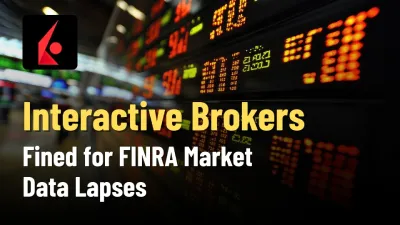简体中文
繁體中文
English
Pусский
日本語
ภาษาไทย
Tiếng Việt
Bahasa Indonesia
Español
हिन्दी
Filippiiniläinen
Français
Deutsch
Português
Türkçe
한국어
العربية
Order Blocks in Forex: The Ultimate Guide for Traders
Abstract:Understanding what is an order block in forex provides an incredibly powerful tool for your trading arsenal. They provide a logical framework for understanding price action and identifying high-probability trading opportunities. However, they are not a holy grail. No strategy is 100% accurate. True and lasting success in trading comes from the disciplined execution of a well-defined plan, rigorous risk management, and a commitment to continuous learning. Use this guide as your foundation, practice diligently, and you will be well on your way to trading with a deeper understanding of the market.
Beyond Candlesticks: The “Smart Money” Footprint
Ever watch the market reverse with amazing accuracy just moments after your stop-loss was hit? It's a frustratingly common experience for many traders. This is often not random chance but the calculated footprint of “smart money”—the large financial institutions, banks, and hedge funds whose huge trading volume controls market direction. They don't just click “buy” or “sell”; they plan price movements. An order block is the clearest evidence of this planning left on your charts.
In the simplest terms, an order block is a specific price area where large institutions have placed a significant group of orders. When price returns to this area, a strong reaction is expected as these institutions defend their position. Understanding this concept moves you from simply reacting to price to predicting it, by following the trail of institutional money.
This complete guide will give you a professional-level understanding of order blocks. We will cover:
- What an order block is and the market mechanics behind how it forms.
- How to correctly identify high-probability order blocks on any chart.
- A step-by-step, rule-based strategy for trading them effectively.
- Advanced details and common mistakes that traders must avoid.
Breaking Down Order Block Anatomy
To trade order blocks effectively, we must first build a solid theoretical foundation. Moving beyond a simple definition allows us to tell high-quality setups from market noise. The anatomy of an order block is precise, and understanding its parts is the first step toward mastery.
The Clear Definition
An order block is defined by the last opposing candlestick before a strong, aggressive move in the opposite direction. Specifically:
A bearish order block is the last up-candle before a significant and aggressive down-move.
A bullish order block is the last down-candle before a significant and aggressive up-move.
This candle represents a zone where smart money built their positions before starting a major price swing. The following aggressive move is the key signal that a large volume of orders has entered the market.
Two Primary Types
While the logic is the same, the application differs depending on market direction. We can categorize them into two primary types: bullish and bearish. Understanding their distinct characteristics is crucial for proper identification.
| Characteristic | Bullish Order Block | Bearish Order Block |
| Definition | The last down-candle before a strong, aggressive move upwards. | The last up-candle before a strong, aggressive move downwards. |
| Location in Structure | Typically found at the bottom of a swing low or after a pullback in an uptrend. | Typically found at the top of a swing high or after a rally in a downtrend. |
| Price Action Following | A sharp, energetic rally that breaks previous market structure to the upside. | A sharp, aggressive drop that breaks previous market structure to the downside. |
| What it Signals | A significant build-up of buy orders. Expect price to be supported at this level. | A significant build-up of sell orders. Expect price to be resisted at this level. |
High-Probability Characteristics
Not all last opposing candles are created equal. A true, high-probability order block has specific, non-negotiable characteristics that confirm its significance.
- Significant Displacement/Imbalance: The move away from the order block must be powerful and energetic. This creates what smart money traders call an *imbalance* or a *Fair Value Gap (FVG)*. This is a visible gap on the chart between the high/low of the order block candle and the candle two periods after it, signaling an inefficient, one-sided move that price will likely want to revisit to “rebalance.”
- Takes Liquidity: The most powerful order blocks are those that form immediately after grabbing liquidity. For a bullish order block, this means the price first dips below a previous swing low, triggering sell-stops, before reversing. For a bearish order block, price often spikes above a previous swing high, triggering buy-stops, before the major reversal. This liquidity grab acts as the fuel for the following institutional move.
The “Why”: Understanding Market Mechanics
To truly gain an edge, you must understand *why* order blocks form. It's not a magic pattern; it's a logical result of how large institutions must operate in the market. Thinking like they do elevates your trading from pattern-spotting to understanding the market's story.
Imagine trying to turn a massive cargo ship. You can't simply crank the wheel and expect an instant 90-degree turn. It requires a slow, careful process. The same is true for institutions trying to deploy hundreds of millions or even billions of dollars.

The Role of “Smart Money”
An institution cannot execute a single $500 million buy order without causing the price to skyrocket against them, resulting in a terrible average entry price. This is known as slippage. To avoid this, they must be strategic and build their position in pieces, often hiding their activity from the broader market. The order block is the zone where this accumulation or distribution occurs. They layer their orders within a tight price range, absorbing all opposing orders until they are ready to let the market move.
Accumulation and Mitigation
Let's break down the process. An institution wants to buy a large amount of EUR/USD.
1. Accumulation: They begin buying in a specific price zone. To facilitate these buys without pushing the price up too quickly, they may also place small sell orders to create selling pressure and keep the price contained. This activity forms the order block candle.
2. The Move: Once their core position is built, they remove their sell orders and allow or even fuel the price to move up aggressively. This aggressive move is the displacement that leaves behind the imbalance.
3. Mitigation: The initial small sell orders they used to control price are now at a loss. Price will often return to the origin of the move—the order block—for one final, crucial reason: to allow the institution to close out those initial sell orders at or near breakeven. This is called *mitigation*. At the same time, they may use this opportunity to add to their primary long position at a favorable price before the next leg up. This return to the order block is the high-probability entry point we as retail traders look for.
Stop Hunts and Liquidity Grabs
Here is where firsthand experience becomes critical. We often see price spike just below a clean, obvious low, only to violently reverse and rally higher. This is not a coincidence. That spike is a *liquidity grab* or *stop hunt*. Institutions know that retail traders place their stop-losses below swing lows. By pushing the price down to trigger those stops, they accomplish two things:
1. They create a cascade of sell orders (from the triggered stops), which they can use to fill their own large buy orders at a better price.
2. They remove opposing interest from the market, clearing the path for the price to move in their intended direction.
This engineered liquidity grab often forms the wick of the order block candle itself. From experience, we learn that an order block preceded by a clean stop hunt is one of the most powerful setups you can find. It's the market showing its hand, revealing the true intention of institutional players.
A Practical Identification Guide
Theory is essential, but a trader's real skill lies in practical application. Identifying valid order blocks on a live chart requires a systematic, rule-based process. This section will provide a clear, step-by-step method to bridge the gap between concept and execution. For this process to be effective, it's critical to use clean, high-quality charts.
Step-by-Step Identification
We follow a top-down approach, starting from a higher timeframe to establish the overall market story before drilling down to find our precise point of interest.
1. Start on a Higher Timeframe (e.g., 4H, Daily): The first step is to understand the main trend. Is the market making higher highs and higher lows (uptrend) or lower lows and lower highs (downtrend)? Order blocks are most powerful when they align with this higher-timeframe direction.
2. Identify a Break of Structure (BOS): Look for a clear and decisive break of a previous swing high (in an uptrend) or swing low (in a downtrend). A BOS confirms a continuation of momentum and validates the strength of the move that caused it. This move originates from our potential order block.
3. Locate the Origin Candle: Now, trace that structure-breaking move back to its origin. Pinpoint the last opposing candle right before the impulse began. For a bullish BOS, this will be the last down-candle. For a bearish BOS, it will be the last up-candle. This is your candidate for the order block.
4. Check for Imbalance (FVG): This is a critical validation step. Look at the three-candle sequence: the candle before the order block, the order block itself, and the candle after. There must be a visible gap between the low of the first candle and the high of the third candle (for a bearish OB) or the high of the first candle and the low of the third candle (for a bullish OB). This confirms the move was aggressive and inefficient.
5. Mark the Zone: Once all criteria are met, draw a rectangle covering the entire range of the order block candle, from its high to its low. This rectangle is your Point of Interest (POI) zone, where you will anticipate a price reaction upon its return.
Annotated Chart Examples
Bullish Setup Example: Imagine a chart of GBP/USD on the 4-hour timeframe. We see a clear uptrend. Price pulls back, dips just below a previous swing low (the liquidity grab), and then rallies aggressively, breaking the most recent swing high (the BOS). We would annotate the chart to show:
- An arrow pointing to the swing low that was raided for liquidity.
- The last down-candle before the aggressive rally, marked as the “Bullish Order Block.”
- The clear imbalance (FVG) left behind by the strong up-move.
- An arrow pointing to the “Break of Structure” (BOS) where the price broke the previous high.
Bearish Setup Example: Now, picture a chart of EUR/JPY on the 1-hour timeframe in a downtrend. Price rallies up, spikes just above a previous swing high, and then collapses, breaking the last swing low. The annotations would highlight:
- The spike above the high, labeled “Liquidity Grab.”
- The last up-candle before the collapse, marked as the “Bearish Order Block.”
- The following “Break of Structure” (BOS) to the downside.
- The visible “Imbalance” created by the sharp drop.
Context is King
It cannot be stressed enough: an order block does not exist in a vacuum. Its validity is determined by its context within the broader market structure. A bullish order block found at a key support level in a clear 4-hour uptrend is a high-probability setup. The same candle pattern found in the middle of a choppy, ranging market or against a strong daily downtrend is a low-probability gamble. Always trade with the higher-timeframe wind at your back.
The Order Block Trading Strategy
Having identified a high-probability order block, we now need a complete, rule-based plan to trade it. A discretionary approach leads to inconsistent results. A systematic playbook for entry, risk management, and profit-taking is what separates professional traders from amateurs. This is your playbook.
The Core Premise: The Retest
The highest-probability trade is not taken as the order block forms, but when the price returns to it. As we discussed, this return trip is known as the *mitigation* or *retest*. We are anticipating that institutions will defend this price level to protect their original position and potentially add to it. Our strategy is designed to enter alongside them as they do. Once we have our zone marked on a higher timeframe (e.g., 4H), we wait patiently for the price to trade back into that rectangle.
Precision Entry Criteria
Once the price touches our order block zone, we have two primary models for entry. Neither is universally “better”; they represent a trade-off between precision and the risk of missing a move.
1. Risk Entry (or “Limit Order Entry”): This involves placing a limit order at the top edge (for a bullish OB) or bottom edge (for a bearish OB) of the zone. You enter the trade as soon as the price touches the block.
- *Pros:* Ensures you don't miss the trade if the reaction from the zone is immediate and aggressive.
- *Cons:* Lower confirmation, as the price could potentially trade deeper into the block or even through it.
2. Confirmation Entry: This involves waiting for the price to enter the higher-timeframe order block zone and then dropping to a lower timeframe (e.g., 5-minute or 15-minute) to look for a specific reaction. We wait for the price to show its hand by creating a smaller-scale break of structure in our intended direction *on the lower timeframe*. For instance, in a 4H bullish OB, we would wait for the price on the 5M chart to shift from making lower lows and lower highs to creating a higher high. We then enter on the following pullback.
- *Pros:* Provides much higher confirmation that the OB is holding, leading to a higher win rate.
- *Cons:* You may miss the trade if the price reacts sharply from the edge of the zone and doesn't provide a lower-timeframe pullback.
Logical Stop-Loss Placement
Risk management is paramount. From years of experience, we know that the trade idea is invalidated if the price trades completely through the order block. Therefore, the logical place for a stop-loss is just beyond the zone's outer boundary.
- For a bullish order block, the stop-loss should be placed a few pips below the low of the order block candle.
- For a bearish order block, the stop-loss should be placed a few pips above the high of the order block candle.
If the stop-loss is hit, it means the institutional interest was not there or was overpowered. We accept the small, defined loss and move on. There is no reason to give the trade more room, as the entire premise has been proven wrong.
Targeting Your Take-Profit
A trade is only successful if you secure your gains. Our targets should be just as logical as our stop-loss. We aim for significant liquidity pools where the price is likely to be drawn.
- For a long trade from a bullish order block, the primary target should be the next significant swing high on the higher timeframe.
- For a short trade from a bearish order block, the primary target should be the next significant swing low.
It is also wise practice to take partial profits. A common approach is to close a portion of your position (e.g., 50%) when the trade reaches a 1:2 or 1:3 risk-to-reward ratio. At this point, you can move your stop-loss to breakeven, creating a “risk-free” trade on the remaining portion, which you can let run toward the final target.
A Complete Trade Walkthrough
Let's visualize a full trade. We identify a bearish order block on the 4H chart after a liquidity grab and a break of structure. We mark the zone. We wait, perhaps for several hours or a day, for the price to rally back up into our zone. Using a confirmation entry, we switch to the 15M chart. We see the price push into our zone, lose momentum, and then break a recent 15M swing low. We enter a short trade on the small pullback after this 15M BOS. Our stop-loss is placed just above the high of the 4H order block candle. Our first take-profit is set at a 1:2 R:R, and our final target is the major 4H swing low. The trade plays out, hitting our partial profit target, and we move our stop to breakeven before price eventually reaches the final target.
Advanced Details and Pitfalls
As you begin to apply this concept, you will encounter real-world complexities. Understanding these details and being aware of common beginner mistakes is what will accelerate your learning curve and help you avoid costly errors. This is where experience provides lessons that theory alone cannot.
High-Prob vs. Low-Prob Blocks
The key to long-term success is selectivity. You must be able to differentiate between A-grade setups and mediocre ones.
- High-Probability Order Blocks are formed after a clear raid on liquidity (a stop hunt), are aligned with the higher-timeframe trend and market structure, and create a large, obvious imbalance (FVG). They represent a clear institutional footprint.
- Low-Probability Order Blocks are often found in the middle of a trading range with no clear trend, are formed against the dominant market structure, or have a weak, corrective move away from them with little to no imbalance. These are often just random fluctuations and should be ignored.
The Beginner's Trap: Painting Blocks Everywhere
One of the most common mistakes we see is that once a trader learns what is an order block in forex, they start seeing them everywhere. Every minor swing's last candle becomes a potential zone. This is a recipe for over-trading and confusion. You must be ruthlessly selective. Remember the strict criteria: a clear break of structure must occur, and a significant imbalance must be present. If these elements are missing, it is not a high-probability order block, regardless of how perfect the candle looks. Quality over quantity is the mantra.

OB vs. Breaker vs. Mitigation Block
As you delve deeper into smart money concepts, you will encounter related terms. Understanding the distinction showcases a deeper level of expertise and prevents confusion.
- Order Block: The origin of an aggressive move that breaks structure, as we have discussed at length.
- Breaker Block: This is a bullish or bearish order block that has failed. For example, a bullish order block that was supposed to hold price up but instead gets violated by a strong down-move. When the price later returns to this *failed* order block, it often acts as resistance. It has “broken” and flipped its function.
- Mitigation Block: This is a price zone where institutions mitigate a losing position, similar to a standard OB. However, a mitigation block is formed when price fails to take out a major high or low but still manages to cause a break in market structure.
For now, master the foundational order block. It is the core concept from which all others are derived.
Integrating Order Blocks into Your System
We have journeyed from a simple definition to a complete, actionable trading strategy. By understanding the “why” behind institutional order flow, you can begin to see the market not as a random series of candles, but as a structured narrative of liquidity and intent.
Your Key Takeaways
To distill this guide into its most critical components, remember these points:
- Order blocks are the visible footprints of institutional accumulation and distribution.
- Always identify them in the context of higher-timeframe market structure and liquidity grabs.
- A rule-based plan covering entry, stop-loss, and take-profit is non-negotiable for consistency.
- Selectivity is your greatest ally. Focus only on high-probability setups that meet all criteria.
The Crucial Role of Practice
We must give you this final, crucial piece of advice: do not start trading this concept with real money tomorrow. Open your charts and go back in time. Identify setups based on the rules. Mark your entry, stop, and target. Then, move the chart forward candle by candle to see how it played out. This process, known as backtesting, is where you will build the screen time and confidence necessary for live trading. Follow this with practice on a demo account until you achieve consistent results.
A Final Word: A Powerful Tool
Understanding what is an order block in forex provides an incredibly powerful tool for your trading arsenal. They provide a logical framework for understanding price action and identifying high-probability trading opportunities. However, they are not a holy grail. No strategy is 100% accurate. True and lasting success in trading comes from the disciplined execution of a well-defined plan, rigorous risk management, and a commitment to continuous learning. Use this guide as your foundation, practice diligently, and you will be well on your way to trading with a deeper understanding of the market.
Disclaimer:
The views in this article only represent the author's personal views, and do not constitute investment advice on this platform. This platform does not guarantee the accuracy, completeness and timeliness of the information in the article, and will not be liable for any loss caused by the use of or reliance on the information in the article.
Read more

JP Markets Review: High Spread & Commission, Fake Bonus Lure & Withdrawal Hassles Frustrate Traders
Have you been lured into opening a JP Markets Forex Trading Account with a high bonus offer that never existed? Have you found the spread and commission charges higher on JP Markets Login than what’s advertised on the broker’s website? Wondering why you are not able to withdraw funds from your trading account? Well, all of these hint at a potential forex investment scam. Many traders have expressed their disappointment while sharing the JP Markets Review online. In this article, we have shared certain complaints. Take a look at them.

Angel one 2025 Review & Complaints
Angel One is a well-known name in the forex market. People are familiar with the name , but is this broker really worth your interest? What do real users say about Angel One, and what complaints have they shared? In this Angel One 2025 review, you will explore all these details.

Exclusive Markets Under the Scanner: Traders Report High Swap Charges, Deposit Discrepancies & More
Is your forex trading account experience at Exclusive Markets far from good? Do you witness high swap fees and daily charges? Does the deposit fail to reflect in your Exclusive Markets Login? Don’t receive adequate response from the customer support official on your trading queries? You are not alone! Traders have already alleged that the forex broker is involved in these activities. In this Exclusive Markets WikiFX review article, we shared some traders’ comments. Read on to know about them.

Interactive Brokers Fined for FINRA Market Data Lapses
Interactive Brokers fined $150,000 by FINRA over Vendor Display Rule violations and supervisory gaps; firm adds real-time consolidated data displays.
WikiFX Broker
Latest News
Is Nash Markets Regulated or Risk? Truth About Nash Markets’ License & Withdrawal Issues
Webull Widens Crypto Futures with Coinbase Derivatives
Latest FCA Daily Alerts and Consumer Warnings for 2025
CySEC Blocks Certification Access to Combat Advisor Impersonation
Angel one 2025 Review & Complaints
Exclusive Markets Under the Scanner: Traders Report High Swap Charges, Deposit Discrepancies & More
Pinched By Penny Shortage, US Retailers Beg Congress To Step In
Saxo Bank Japan Expands European Stock Portfolio with UBS, Ferrari, and Other Major Names
Amillex Broker Affiliate Program: A Complete Guide to Earning with Referrals
New SC Rules Take Effect in November 2025: What’s Next for Finfluencers?
Currency Calculator



